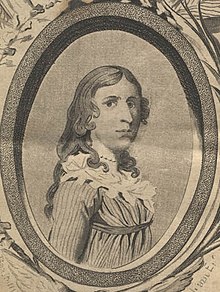Deborah Sampson
| Deborah Sampson | |
|---|---|

Frontispiece of The Female Review: Life of Deborah Sampson, the Female Soldier in the War of Revolution.
|
|
| Born |
December 17, 1760 Plympton, Massachusetts |
| Died | April 29, 1827 (aged 66) Sharon, Massachusetts |
| Buried at | Rock Ridge Cemetery, Sharon, Massachusetts |
| Service/branch |
|
| Years of service | 1782-1783 |
| Rank | Private |
| Unit | Light Infantry Company, 4th Massachusetts Regiment |
| Battles/wars | American Revolutionary War |
| Spouse(s) | Benjamin Gannett |
| Relations | 3 children (Earl, Mary, Patience) |
| Other work | Teacher Weaver Soldier Lecturer Farmer |
Deborah Sampson Gannett (December 17, 1760 – April 29, 1827), better known as Deborah Samson or Deborah Sampson, was a woman who disguised herself as a man in order to serve in the Continental Army during the American Revolutionary War. She is one of a small number of women with a documented record of military combat experience in that war. She served 17 months in the army under the name "Robert Shirtliff" (also spelled Shirtliffe or Shurtleff) of Uxbridge, Massachusetts, was wounded in 1782, and was honorably discharged at West Point, New York, in 1783.
Deborah Sampson was born on December 17, 1760, in Plympton, Massachusetts, into a family of modest means. Her father was Jonathan Sampson (or Samson) and her mother was Deborah Bradford. Her siblings were Jonathan (born 1753), Elisha (born 1755), Hannah (born 1756), Ephraim (born 1759), Nehemiah (born 1764), and Sylvia (born 1766). Deborah's mother was the great-granddaughter of William Bradford, Governor of Plymouth Colony. Some of Deborah's ancestors included passengers on the Mayflower.
Deborah was told that her father had most likely disappeared at sea, but evidence suggests that he actually abandoned the family and migrated to Lincoln County, Maine. He took a common-law wife named Martha, had two or more children with her, and returned to Plympton in 1794 to attend to a property transaction. A 1770 murder indictment in Maine named someone called Jonathan Sampson as the defendant; it is not known for certain whether this individual was Deborah’s father because there are no existing records containing biographical details about the defendant.
When Deborah's father abandoned the family, her mother was unable to provide for her children, so placed them in the households of friends and relatives, a common practice in 18th-century New England. Deborah was placed in the home of a maternal relative. When her mother died shortly afterwards, she was sent to live with Reverend Peter Thatcher's widow, who was then in her eighties. It is thought that she learned to read while living with the widow Thatcher, who might have wanted Deborah to read Bible verses to her.
...
Wikipedia
